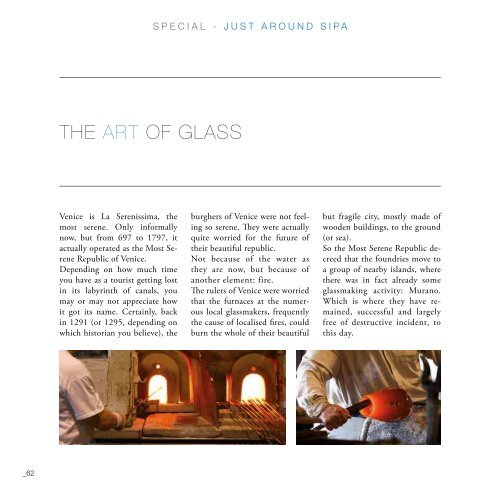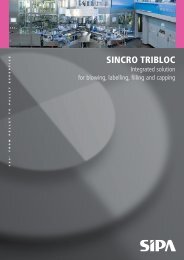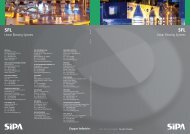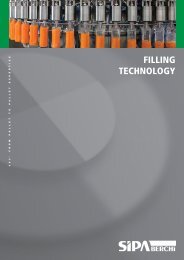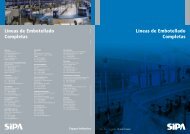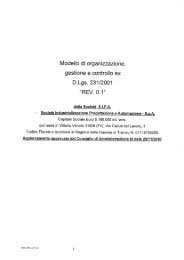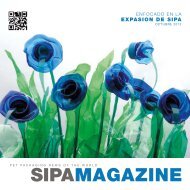C14_SIPA Magazine_issue4_2013_uk.pdf
C14_SIPA Magazine_issue4_2013_uk.pdf
C14_SIPA Magazine_issue4_2013_uk.pdf
Create successful ePaper yourself
Turn your PDF publications into a flip-book with our unique Google optimized e-Paper software.
_62<br />
THE ART OF GLASS<br />
Venice is la serenissima, the<br />
most serene. only informally<br />
now, but from 697 to 1797, it<br />
actually operated as the Most serene<br />
republic of Venice.<br />
depending on how much time<br />
you have as a tourist getting lost<br />
in its labyrinth of canals, you<br />
may or may not appreciate how<br />
it got its name. Certainly, back<br />
in 1291 (or 1295, depending on<br />
which historian you believe), the<br />
sPecial - Just around siPa sPecial - Just around siPa<br />
burghers of Venice were not feeling<br />
so serene. They were actually<br />
quite worried for the future of<br />
their beautiful republic.<br />
not because of the water as<br />
they are now, but because of<br />
another element: fire.<br />
The rulers of Venice were worried<br />
that the furnaces at the numerous<br />
local glassmakers, frequently<br />
the cause of localised fires, could<br />
burn the whole of their beautiful<br />
but fragile city, mostly made of<br />
wooden buildings, to the ground<br />
(or sea).<br />
so the Most serene republic decreed<br />
that the foundries move to<br />
a group of nearby islands, where<br />
there was in fact already some<br />
glassmaking activity: Murano.<br />
Which is where they have remained,<br />
successful and largely<br />
free of destructive incident, to<br />
this day.<br />
centuries of highquAlitY<br />
glAssMAKing<br />
Concentrating the glassworks in<br />
Murano served the serenissima<br />
well, since the republic was jealous<br />
of the decorative glassmaking<br />
art that had long made it famous<br />
around the world.<br />
now, it could better control the<br />
activities, since the glassmakers<br />
were forced to live on the islands<br />
and could not leave Venice without<br />
a special permit. Many glassmakers<br />
did actually manage to<br />
flee abroad, taking their famous<br />
techniques with them. nevertheless,<br />
Murano’s glassmakers held a<br />
monopoly on high-quality glassmaking<br />
for centuries, developing<br />
or refining many technologies,<br />
including crystalline glass, enameled<br />
glass (smalto), glass with<br />
threads of gold (aventurine),<br />
multicolored glass (millefiori),<br />
milk glass (lattimo), and imitation<br />
gemstones made of glass.<br />
The most important crisis that<br />
hit the industry was that of the<br />
fifteenth century, when production<br />
of bohemian crystal began,<br />
possibly inspired by the same<br />
Murano glass. but Murano and<br />
Venice endured, especially since<br />
the time that glass has been used<br />
for the production of chandeliers,<br />
still one of the best-known<br />
artefacts of Murano.<br />
They may have been captive, but<br />
Murano’s glassmakers soon became<br />
prominent citizens.<br />
among non-nobles, for example,<br />
only they could marry the daughters<br />
of patricians.<br />
The republic in fact issued a decree,<br />
following the unrest that<br />
occurred in the Great Council<br />
of Murano, that only those who<br />
were born on the island or had<br />
purchased property there could<br />
call themselves citizens of Murano.<br />
and in 1602, the mayor barbarigo,<br />
in a census of the islanders,<br />
called for the compilation of<br />
a “Golden book.”<br />
The procedure for obtaining registration<br />
in this book was neither<br />
simple nor short, and in fact<br />
_63


